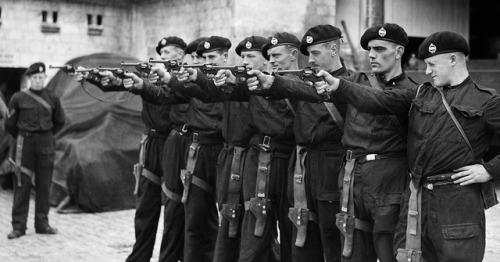historicalfirearms:In Action: Enfield Revolver No. 2Mk IThe photograph above features men of the 4th
historicalfirearms:In Action: Enfield Revolver No. 2Mk IThe photograph above features men of the 4th battalion, Royal Tank Regiment practising with their .38 revolvers in a farmyard near Arras, 6 October 1939. The photograph appears to be a publicity photograph taken at the very beginning of a period of relative inactivity on the Western Front during the Second World War known as the Phoney War. During this period the 4th battalion were equipped with Matilda Mk1 - heavily armoured but lightly armed, infantry tanks. The Royal Armoured Corps had been formed just months before on the 4th April 1939. The Royal Tank Regiment, which was the backbone of the new Corps, had been formed back in July 1917. The men are wearing the characteristic black overalls, first issued to the Royal Tank Regiment in the mid 1930s.Development of a .38 calibre service revolver began in the 1920s with Webley & Scott developing an experimental model chambered in .38 based on their MkIV revolver. The British government would take this design and produce it at the state-owned Royal Small Arms Factories. Webley sued the government for producing the pistol without their permission, with the Royal Commission on Awards to Inventors settling the case for just £1,200, covering just half of Webley’s development costs. The Enfield revolver was finally adopted in 1932 as the Revolver No. 2 Mk I. The revolver, chambered in the smaller .38/200 round replaced the older .455 Webleys. Introduced in 1939, the No. 2 Mk I* had a spur-less hammer (source)In the photograph we see the men stood in the prescribed classic single-handed shooting stance, with hand on hip. Only one of the men has a lanyard attached to his pistol while some of the men appear to have paper armoury tags still attached to their pistol’s at the lanyard ring at the base of the pistol grip. In the background we can see a corporal, also with revolver in drop leg holster.As the men are in the process of firing the revolvers, the hammer is back and it is difficult to see if they are the adapted No. 2Mk I* which had its hammer spur ground off. This was to confine the user to double action shooting only. However, it’s just possible to see the outline of the hammer on some of the revolvers suggesting these pistols are the original No. 2Mk I pattern of revolver, still with hammer spurs. This seems likely as the men are probably practising single action shots with the pistol cocked and the hammer back.Sources:Images: 1 2If you enjoy the content please consider supporting Historical Firearms through Patreon! -- source link
Tumblr Blog : www.historicalfirearms.info


